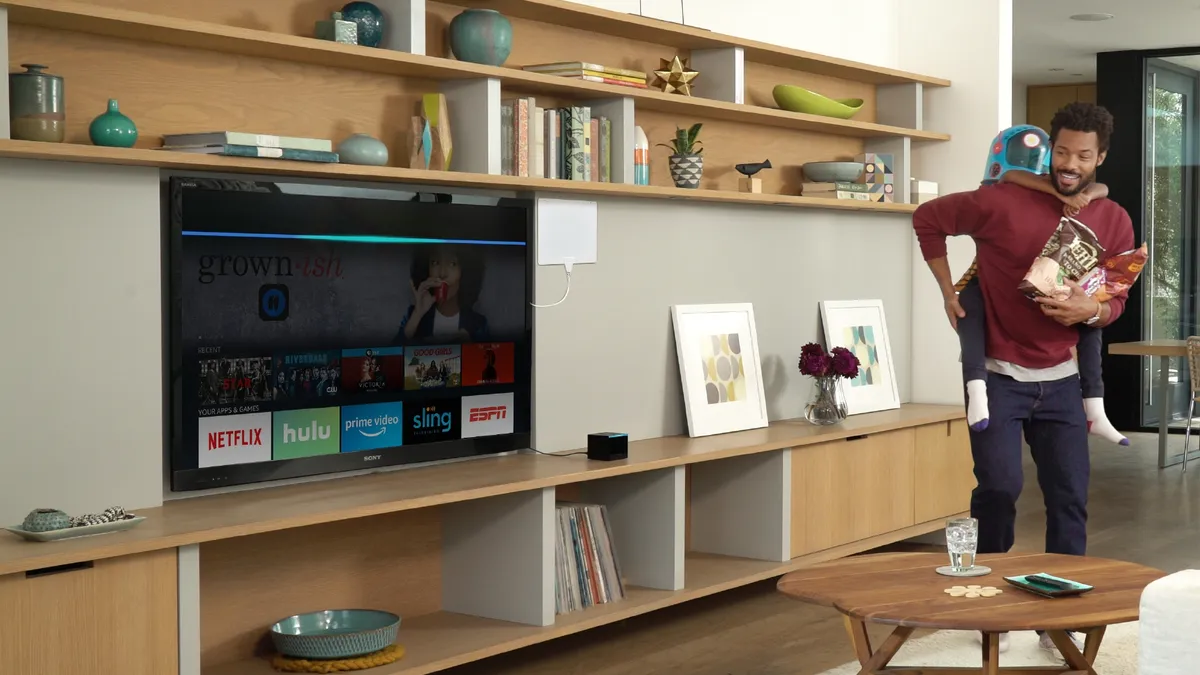If brands are occasionally finding it difficult to see the long-term future of investing in traditional linear television, the big picture for connected TV might be even blurrier.
In August, for example, a report from eMarketer predicted that 60% of the U.S. population will watch connected TV (CTV) at least once a month by 2022. That kind of growth has created a wave of interest among platform providers and networks, including Hearst Television Inc, which announced an over-the-top (OTT) ad platform involving a partnership with Roku.
There's also the sense that, as more digitally native consumers come of age, CTV may be one of the few ways to reach cord cutters or "cord nevers" who eschew traditional cable TV packages, according to several agency executives who spoke with Marketing Dive. A September 2018 survey of 2,000 people showed streaming leads as the most-used video platform by millennials at 49%, and 45% for Gen Z, according to data shared by Minneapolis-based research firm Magid.
Behind the scenes, however, agencies and marketers say CTV faces a number of growing pains, including a highly complex ecosystem of players, difficulties with inventory and the basic question of where the necessary budget should come from. Should brands add CTV as its own line item, for instance, as a digital add-on or make it part of the overall TV budget?
"What excites me the most is considering connected TV as an extension of digital spend, because it allows for more segmenting and advanced tracking on a larger scale," said Jeff Ratner, chief media officer at digital agency iCrossing. "If you think of it this way, connected TV presents brands that have not coughed up big dollars for TV an opportunity to get more granular with their targeting."
Targeting without cookies
The exact nature of targeting may not always be what brands expect, however. While marketers can aim CTV ads at a specific household, for instance, the platforms don't use cookies that could help connect to a specific individual. This can also affect delivery tracking and evaluating duplication and attribution. The fact that so many living rooms are becoming filled with other "smart" devices such as speakers or tablets that use the same sign-in credentials may help offset the challenge, according to Raphael Rivilla, media and connections planning partner at Cleveland, Ohio-based agency Marcus Thomas LLC.
"CTV actually offers the same audience targeting capabilities as digital video buys," Rivilla told Marketing Dive, adding that brands can work with a programmatic partner to use first-party data, third-party data and look-alike modeling to target their spots. "All of these can infer and connect relationships between cookies, mobile device IDs, households, smart TVs or connected TV devices."
A fragmented landscape
While marketing through linear TV might have once meant looking at a handful of major networks, brands exploring CTV are faced with a daunting mix of choices. These include those making smart TVs and OTT devices like Apple TVs and Rokus, to gaming consoles like Xbox, to all the different TV sticks such as Amazon Fire and Google's Chromecast.
"Welcome to my life," joked Dan Weiner, senior VP of enterprise sales and connected TV platform at SteelHouse, a Los Angeles-based ad tech firm. "I came from the streaming radio world and it was the same thing when we started to see the audience migration from FM radio. At first there were a couple of a players, like Pandora, iHeart and Rdo. Then came Apple, then Amazon and it was a lot more complicated."
"The big advantage of CTV over linear TV is that it can be measured against other behaviors across devices, which leads to more interesting data points than reach, frequency and viewability."

Raphael Rivilla
Media and connections planning partner, Marcus Thomas
Choosing the right partner and platform will ultimately come down to audience and goals, Weiner said. If a marketer is seeking brand awareness, for instance, he suggested choosing a partner who has similar inventory to linear TV and cable networks. If the goal is to drive specific actions like visiting a website or making a purchase, brands will need platforms and third parties with significant attribution capabilities, he said.
In the absence of traditional third-party verification, however, CTV remains a marketing channel where confirming things like viewability is also complex. Rivilla from Marcus Thomas pointed to Nielsen OTT, a panel-based report that can show marketers reach, frequency and GRP by demographics, as one workaround.
"The big advantage of CTV over linear TV is that it can be measured against other behaviors across devices, which leads to more interesting data points than reach, frequency and viewability," he said.
Given the immersive nature of CTV versus watching programs on a smartphone or laptop, brands should think about metrics like unique completion rates, suggested Chris LaHaise, director of TV solutions at Boston-based DSP Dataxu.
"There are no tabs to click away to, there's no multitasking going on," he said.
Same ads, over and over
The focused attention promised by CTV might be tested, though, if consumers find themselves seeing the same creative over and over again.
"We saw this exact issue when networks began offering content online and monetizing it with ad breaks within the content and around the content," said Jill Rosengard Hill, an executive VP at Magid. "Consumers were disturbed by the frequency of seeing the same sponsor and the same ad."
The frequency issue is being addressed in part through the Interactive Advertising Bureau's new standardized Identifier for Advertising (IFA), which allows for capping in the absence of cookies on CTV and equips brands with the opportunity to eliminate ad repetition and wasted inventory, James Grant Hay, founder and president of Sydney, Australia's Connected TV Marketing Association, said via email.
"The real-time, impression-based nature of CTV buys also allows for granular optimization against performance metrics," he wrote. "Frequency controls also allow brands to target their advertising more effectively through the traditional TV approach of contextual targeting by specific shows, genres and indicative audiences, through data targeting."
"My personal stance is that connected TV advertising is ushering in an almost new golden era of TV advertising. If you're stuck in just doing live linear TV on traditional networks, you're in trouble, and your business is going to get smaller."

Chris Peterson
Managing director, R2C Group
The onus is also on brands to think strategically about their media mix, said Natalee Geldert, director of media services and brand strategies at agency PMG. This could mean coordinating mass media like linear TV against key moments or seasons, while using CTV for more of an evergreen approach that takes advantage of its relatively lower cost. "Be more efficient," she recommends.
Despite the challenges, people like Chris Peterson, managing director at R2C Group, are optimistic about CTV's long-term potential and are already seeing healthy interest from clients who want to use it for specific campaigns to reach homebuyers or other consumers who might ignore — or have never heard of — the concept of "appointment television."
"My personal stance is that connected TV advertising is ushering in an almost new golden era of TV advertising," Peterson said. "If you're stuck in just doing live linear TV on traditional networks, you're in trouble, and your business is going to get smaller."






















